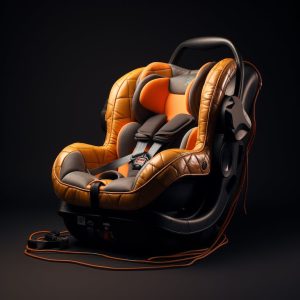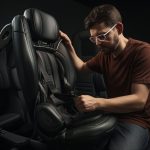If someone asks you to call a security a part of a car that you haven’t driven, most will answer car seatbelts. So we know the different types of seatbelts.
Before 1960, only 15% of individuals used seat belts, which increased to 90%. Safety departments within the car industry are constantly improving the planning of seat belts for passengers’ comfort and safety.
Contents
History of Car Seat Belts
In 1946, retractable seat belts were first invented within us and were first introduced. At the time, these belts weren’t mandatory for the protection of a vehicle.
There was no law then, so there was no got to wear a seatbelt. Decades later, the principles for enforcing these became mandatory.
In 1946, retractable seat belts were first invented within us and were the primary to be introduced. At the time, these belts weren’t mandatory for the protection of a vehicle.
There was no law then, so there was no got to wear a seatbelt. Decades later, the principles for enforcing these became mandatory.
![Different Types Of Seatbelts [Best Review] 2 different-types-of-seatbelts-2-2322293](https://www.globoautomotives.com/wp-content/uploads/2023/12/Different-Types-Of-Seatbelts-2-2322293.jpg)
Design
Simple modern seat belts tie a strip of webbing individually. It’s basically connected with withdrawal. The retraction is meant through a spool that permits the webbing to rotate around.
When the user pulls the spool towards the webbing, the spool then stands counterclockwise and immediately stops the webbing.
Once released, the online will then return to the highest of the spool. This rewinding action shows the wavelength spot as a part of the roundabout.
Types of seatbelts
There are six types of seat belts in the U.S.A. Such as:
A car with a seat belt
- Lap belts
- Shoulder belts
- 3-point belts
- Automatic seat belt
- belt-in-seats(BIS)
- Five-point-harness
Now I am describing that in a deep way. Please read it attentively & learn about that.
1. Lap belts
The lap belt is the most ancient and primitive style or design among all the seat belts. It crosses the hips by stepping the rider with a two-point protection belt.
While a lap belt can protect the body in your vehicle from getting out of hand, it also doesn’t say that it provides an excessive amount of protection during a crash. Without support across your torso, the upper half of your body is liberal to flop forward.
The lap belt is the most ancient and primitive style or design among all the seat belts. It crosses the hips by stepping the radar with a two-point protection belt. It is not very common at present, but occasionally this seat belt is seen in some cars’ rear seats. Now, most cars use three-point seat belts.
2. Shoulder belts
The shoulder belt is also called a sash; it has two more safety belts. It is used to protect the rider across the torso, protecting the shoulders and buttocks.
This belt is designed to restrain the upper body and to prevent the kind of injury or mishap that riders wear on a lap in crashes. However, it needs to be matched with a lap belt to work well. People often slip under the belt during a “submarine” or crash without a belt in their lap.
Due to that, this type of belt is no longer available in cars. Distant three-point belts have replaced them.
3. 3-point belts
First, you would like to secure the belt to 3 specific points, then extend it across your torso and lap. It’s usually made from an extended piece of cloth called nylon that extends from one shoulder to the other buttock then to the lap.
This safety belt is that the commonest in modern cars. It successfully combines the protective features of the shoulder and collar belt, thus restraining the entire body. Therefore the amount of this seat is extremely high.
4. Automatic seat belt
Automatic seat belts were very fashionable a couple of decades ago, but now they’re scarce. Although designed to supply equivalent protection as three-point belts, there have been some additional benefits.
These included shoulder and collar belts. Passengers would manually fasten their belts, and as soon because the car started moving, their shoulder belts would automatically cover their bodies. The automated belt had a bark that allowed passengers to get rid of the belt manually if they wanted to.
5. Belt-in-Seat (BIS)
The belt-in-seat variation of the three-point life belt where the protected point above the shoulder is really behind the seat rather than the car frame.
This design has many appeals that supported both the comfort and safety of the passengers.
A standard complaint about neck belts is; It reduces neck and shoulder chafing, and a few don’t wear seat belts due to some unhealthy advice. Researchers have also developed BIS sensors, which will answer seat angle changes to form riders safer during rollovers.
6. Five-Point Harness
One of the five-point shoe features is that it protects both shoulders, both hips, and between the legs. The straps are buckled to a particular position on the chest, which can spread the effect evenly within the case of a crash.
These are the foremost common issues with baby car seats. When properly adjusted, they’re going to be converted into one of the safest sorts of safety belts.
Five-point harnesses were also common in many competitive racecars within the past, but after the death of Dale Earnhart during a race, six-point harnesses became widespread. (It was thought that his five-point shoe might be off-center, which is why it contributed to his death.) The six-point shoe had an additional strap between its legs.
Benefits of a seat belt
A car was crashed & in a risky position a seat belt
- Prevent passenger or driver from uncontrolled movement inside the vehicle.
- Preventing the user from moving forward, causing a potential head injury.
- To protect the user from the effects of the windshield to protect the user.
- Ensuring the user is emitted from the vehicle.
- The most stable areas of the body allow the maximum energy of an effect to be absorbed.
Seatbelts Plus Airbags
Here are some life-saving reminders: Seat belts usually work together with your airbags. If the parts of those two vehicles, seatbelts and airbags, work properly during a car accident, it greatly reduces the danger of injury or death. Without a seatbelt, your body will be very stiff, and it can hit the airbag very quickly, which may end in death.
Except for airbags, inertia will throw your body against your seatbelt with all of your weight and speed, you’ll lose control over your body. The belt will still keep you safe in your seat.
So, both of those parts of the car – seatbelts plus airbags – are vital. Now let’s take a better check out the seatbelts.
The Future of Seat Belts
Seat belts are the topic of many innovations over the years, including their design and size. For instance, the belt gets locked during a sudden brake, given the locking withdrawal mechanism involved during a sudden stop or crash.
This may offer you better mobility and luxury while driving, but you’ll effectively resist the impact.
Yet security engineers also still innovate. Some designers are experimenting with four-point harness and criss-cross belt designs to stop side effects and improve safety during rollovers. These will distribute the consequences of front or rear crashes more evenly.
Some manufacturers now offer inflatable seat belts whose functionality deploys very similar to airbags.
These are currently used alphabetically in high-end vehicles, so it remains to be seen whether they can gain popularity.
Conclusion
Seatbelts are an essential part of our lives that we should not neglect. Lack of it can lead to serious injuries in various accidents. Use the belt that will meet the demand according to your convenience and need, but keep in mind that the belt should be of high quality. I hope there is no doubt in your mind about the types of seatbelts.
Relevant post

![Different Types Of Seatbelts [Best Review] 1 different-types-of-seatbelts](https://www.globoautomotives.com/wp-content/uploads/2022/09/Different-Types-Of-Seatbelts-9781787.jpg)



![How To Install A Car Seat Properly [Step By Step] how-to-install-a-car-seat-properly-2](https://www.globoautomotives.com/wp-content/uploads/2022/08/How-To-Install-A-Car-Seat-Properly-2-4438883-300x300.jpg)


